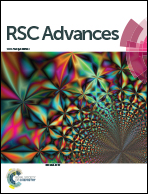Spin glass behavior and enhanced but frustrated magnetization in Ho3+ substituted Co–Zn ferrite interacting nanoparticles†
Abstract
Nanoparticles of Ho3+ substituted in Co–Zn ferrites were synthesised by sol–gel method. The phase formation of these samples has been confirmed by X-ray powder diffraction technique. XRD Rietveld refinement carried out using the FULLPROF program shows that the Co–Zn ferrite retains its single phase cubic structure with space group Fd3m for x ≤ 0.05. Occupancy of the cations is explained on the basis of site preference, size and valance of the substitution cations. The nanostructure and morphology of prepared samples were investigated by field emission scanning electron microscopy and transmission electron microscopy. The elemental percentage of the constituent ions was determined using energy dispersive spectroscopy. The magnetic interactions among the nanoparticles were analyzed by employing a temperature dependent vibration sample magnetometer, field cooled (FC)/zero field cooled (ZFC) measurements. The ZFC and FC curves diverge below the blocking temperature exhibiting a ZFC cusp at 195–225 K. The saturation magnetization of Co–Zn ferrite increased linearly with Ho3+ substitution for x ≤ 0.05 and almost remains constant thereafter. The frequency dependence of the AC susceptibility measurements was performed on the sample. It shows a peak at around spin freezing temperature, with the peak position shifting as a function of driving frequency, indicating a spin-glass-like transition of the sample.



 Please wait while we load your content...
Please wait while we load your content...